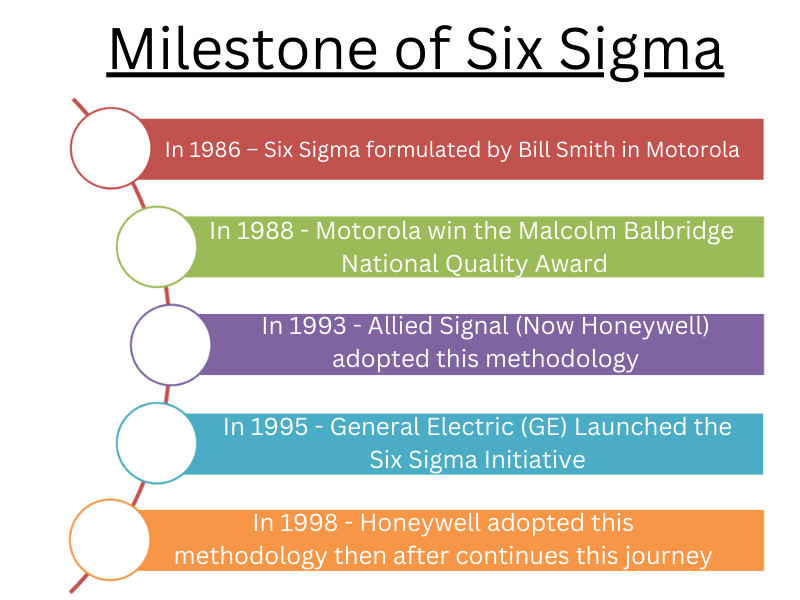Sigma (𝝈) is the Greek letter representing a statistical unit of measure that defines the standard deviation (SD) of a population.
- Six refers to the number of SDs from the technical limit to the mean.
- It measures the variability or spread of the data.
- 6 sigma is a largely structured strategy.
- It’s a perfect and flexible system for achieving, sustaining, and maximizing business success.
- It’s further about the culture than the tools and all the people who espoused Quality in everything they do.
- It’s people driving improvements based on data and data and a detailed roadmap of process enhancement.
- It’s an ambition that extends and strengthens quality and productivity efforts.
- The old faith was high quality = high cost but the new belief is high quality = low cost.
- You can fluently understand this concept by the below analysis of cost vs quality
We will cover the following topics in this blog
- History of Six Sigma
- Milestones
- Benefits of Six Sigma Implementation
- What’s the Six Sigma concept?
- What are the Six Sigma principles?
- Why is it called Six Sigma?
- Meaning of Six Sigma with Examples
- 3 sigma vs 6 sigma Process

History of Six Sigma
- Motorola developed this concept in 1987.
- It’s mainly a bunch of several quality tools.
- One of the most important tools of this methodology is the Control Chart.
- Control Charts were developed way back in 1924 by quality practitioner Walter A. Shewhart.
- Bill Smith of Motorola is considered to be the father of six sigma.
- Mikel Harry was also the Co-founder and he was now and then referred to as the father of six sigma’. ( source Wikipedia)
- Motorola was the first company to admit the Malcolm Baldridge National Quality Award in the year 1988.
- Looking at the success of six sigma at Motorola number of other companies, similar as General Electric, Dow Chemical, DuPont, Honeywell, and
Whirlpool embraced this tool. - These are some of the early adopters.
- By embracing this methodology, multiple companies have improved their operation, reduce their defects level, and made their clients satisfied.
- Jack Welch of General Electric has made six sigma further popular around the world.
- In General Electric, employee preferences were depending on whether the employee had a specific six sigma belt or not.
Milestones
- 1986 six sigma stated by Bill Smith in Motorola.
- 1988 Motorola becomes the first company to win the Malcolm Baldridge National Quality Award.
- 1993 Allied Signal ( Now Honeywell) embraced this methodology.
- 1995 General Electric (GE) launched the six sigma action.
- 1998 Honeywell adopted this method.

Benefits of Six Sigma Implementation
- This Project improves the capability of their business.
- It increases the performance and drops in variation.
- Drop the defect generation.
- Improve the profit of the association.
- This project Improves employee morale and provocation.
- It improves in quality of products and client satisfaction.
- Using six sigma Methodology, an association can develop a strategy and implement proper action for profit and increase, cost reduction, and
improvements. - Six sigma Methodology helps management to effect a vision of the association.
- It helps to set the measure and after sustaining and maintaining the measure further improves the measure this methodology helps us to
continuously improve the system. - By Six Sigma methodology, associations can set a goal and guide the team to work towards achieving it.
- It calculates the process performance using its own unit known as 𝝈 unit like our performance is 4𝝈, 5𝝈, etc.
- It’s a robust methodology for problem-solving and improvement.
What’s the Six Sigma concept?
It can be understood in three different ways
1. Methodology Approach
- DMAIC Methodology was applied for the Improvement Project.
- DMAIC is a structured problem-solving roadmap and implementation
2. Philosophy Approach
- Reduce variation in your process and take client-focused, data-driven deliverances.
3. Metric Approach
- Defects Per Million chances.
- DPMO allows you to take the complexity of the product/ process into account.
- The rule of thumb is to consider at least three chances for a physical part/ component – one for form, one for fit, and one for function, in absence of
better considerations.
What are the Six Sigma principles?
- Reduce the variation
- Maintain and improve the process at the specified mean
- Removing the defects and wastes
- Increase client satisfaction
- Increase Productivity and Profitability
Why is it called Six Sigma?
How multiple standard deviations fit within each side of the specification limit is the 𝝈 position of the process.
The concept of Mean, Central Tendency, and Standard Deviation is the most important to understand the concept of Six Sigma.
01. Mean It’s the numbers normal of a process data set.
02. Central tendency It’s the tendency of data to be around this mean or average value
03. Standard Deviation (σ) It’s a measure of variation.
- Higher improved standard deviation means the value of the data set to spread in a wide range.
- Lower standard deviation means the values of data are near to the mean.
- If the value of sigma is lower also we can fix further 𝝈 between process normal and specification limit so the improved 𝝈 position is good.
There are two types of the specification limit
(a) Lower Specification Limit (LSL) and
(b) Upper Specification Limit (USL)
Simply, we can say that the specification limit is the minimum and maximum satisfactory limits of the client’s demand. 𝝈 is the capability of the process, improved the 𝝈 position means to lower the defects, and lower the 𝝈 position means advanced the defect.

Meaning of Six Sigma with Example
- Sigma Level vs DPMO ( Defects per Million chances) vs Yield
- You can fluently understand the comparison of 𝝈 Position vs DPMO vs Yield from the below picture

- From the above table, we can fluently say that as the 𝝈 position increase the defects drop.
- For illustration, in 4𝝈 process, the defects are 6210 per million chances and for 5𝝈 the defects are 230 per million chances and for six sigma the
defects are3.4 per million chances.
How Good is Good enough?
- 99.9 is earlier really GOOD
- But what could be at a quality level of99.9 ( i.e. 1000 ppm)
Examples
- 1 wrong medication customs per 1000 prescriptions
- 1 brake fail per 1000 recently manufactured auto/ bike
- 1 airbag doesn’t open per 1000 auto
- 1 airplane crash per 1000 lift
- 1 pupil fail per 1000 pupil
- 1 person reach late at cinema per 1000 person
So to avoid this kind of situation we’ve to be more accurate and precise.
3 sigma vs 6 sigma Process
- You can fluently understand the difference between the two processes by applying the below picture.

and how to implement lean tools


